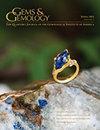Inclusions in Natural, Synthetic, and Treated Diamond
IF 1.6
3区 地球科学
Q2 MINERALOGY
引用次数: 3
Abstract
See end of article for About the Authors. GEMS & GEMOLOGY, Vol. 54, No. 4, pp. 428–429, http://dx.doi.org/10.5741/GEMS.54.4.428 © 2018 Gemological Institute of America many gem-quality diamonds are free of such diagnostic characteristics and will require advanced gemological testing to determine whether they are mined, laboratory grown, or treated. For example, chromian garnet inclusions can indicate the diamond formed in a peridotitic environment, while omphacite and kyanite would suggest an eclogitic environment. Other features that are notably diagnostic to the gemologist are so-called “flash-effect” colors that decorate lead glass–filled fractures and tapering tubes that indicate laser drilling. Gem-quality synthetic diamonds have been commercially available since 1986; however, recent im-天然、合成和处理过的钻石中的内含物
关于作者,见文章末尾。《GEMS & GEMOLOGY》,Vol. 54, No. 4, pp. 428-429, http://dx.doi.org/10.5741/GEMS.54.4.428©2018美国宝石学研究所许多宝石级钻石不具有此类诊断特征,需要进行高级宝石学测试,以确定它们是开采、实验室生长还是经过处理的。例如,铬石榴石包裹体可以表明钻石形成于橄榄岩环境,而辉长石和蓝晶石包裹体则表明钻石形成于榴辉岩环境。对宝石学家来说,其他值得诊断的特征是所谓的“闪光效应”颜色,这种颜色装饰着铅玻璃填充的裂缝和锥形管,表明是激光钻孔。自1986年以来,宝石级合成钻石已经商业化;然而,最近我
本文章由计算机程序翻译,如有差异,请以英文原文为准。
求助全文
约1分钟内获得全文
求助全文
来源期刊

Gems & Gemology
地学-矿物学
CiteScore
2.90
自引率
19.20%
发文量
10
期刊介绍:
G&G publishes original articles on gem materials and research in gemology and related fields. Manuscript topics include, but are not limited to:
Laboratory or field research;
Comprehensive reviews of important topics in the field;
Synthetics, imitations, and treatments;
Trade issues;
Recent discoveries or developments in gemology and related fields (e.g., new instruments or identification techniques, gem minerals for the collector, and lapidary techniques);
Descriptions of notable gem materials and localities;
Jewelry manufacturing arts, historical jewelry, and museum exhibits.
 求助内容:
求助内容: 应助结果提醒方式:
应助结果提醒方式:


